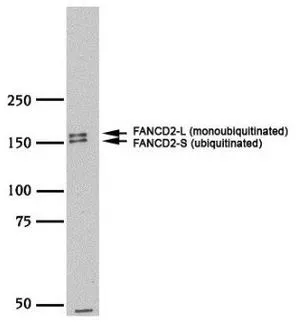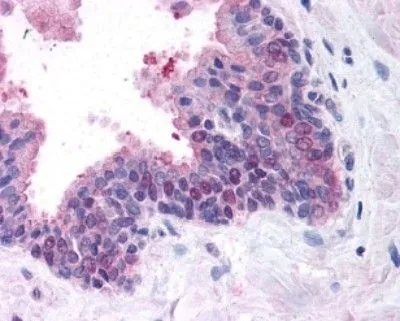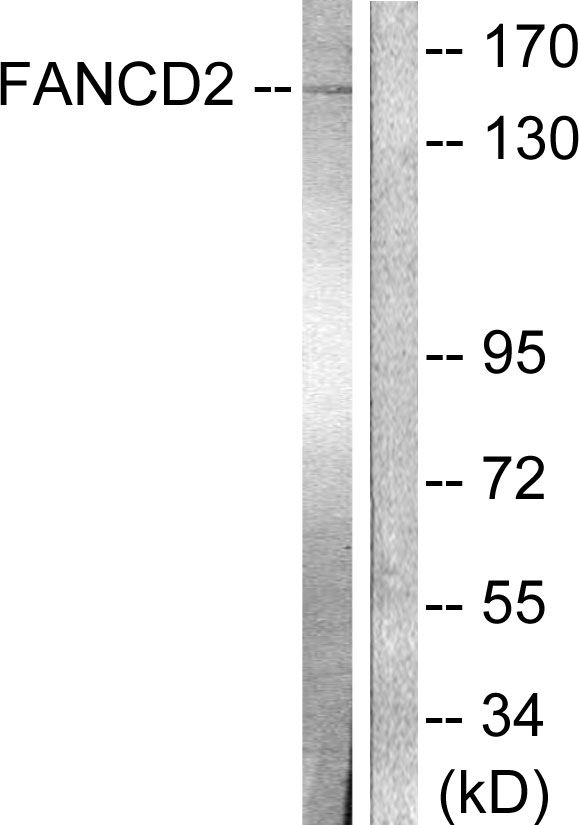
WB analysis of HeLa cell lysate using GTX30142 FANCD2 antibody.
FANCD2 antibody
GTX30142
ApplicationsFlow Cytometry, ImmunoPrecipitation, Western Blot, ImmunoHistoChemistry, ImmunoHistoChemistry Paraffin
Product group Antibodies
ReactivityCanine, Human, Mouse, Primate
TargetFANCD2
Overview
- SupplierGeneTex
- Product NameFANCD2 antibody
- Delivery Days Customer9
- Application Supplier NoteWB: 1:10000 - 1:20000. IHC-P: 2.5 - 5 microg/ml. IP: 1:10 - 1:500. *Optimal dilutions/concentrations should be determined by the researcher.Not tested in other applications.
- ApplicationsFlow Cytometry, ImmunoPrecipitation, Western Blot, ImmunoHistoChemistry, ImmunoHistoChemistry Paraffin
- CertificationResearch Use Only
- ClonalityPolyclonal
- Concentration1 mg/ml
- ConjugateUnconjugated
- Gene ID2177
- Target nameFANCD2
- Target descriptionFA complementation group D2
- Target synonymsFA-D2, FA4, FACD, FAD, FAD2, FANCD, Fanconi anemia group D2 protein, Fanconi anemia complementation group D2
- HostRabbit
- IsotypeIgG
- Protein IDQ9BXW9
- Protein NameFanconi anemia group D2 protein
- Scientific DescriptionThe Fanconi anemia complementation group (FANC) currently includes FANCA, FANCB, FANCC, FANCD1 (also called BRCA2), FANCD2, FANCE, FANCF, FANCG, FANCI, FANCJ (also called BRIP1), FANCL, FANCM and FANCN (also called PALB2). The previously defined group FANCH is the same as FANCA. Fanconi anemia is a genetically heterogeneous recessive disorder characterized by cytogenetic instability, hypersensitivity to DNA crosslinking agents, increased chromosomal breakage, and defective DNA repair. The members of the Fanconi anemia complementation group do not share sequence similarity; they are related by their assembly into a common nuclear protein complex. This gene encodes the protein for complementation group D2. This protein is monoubiquinated in response to DNA damage, resulting in its localization to nuclear foci with other proteins (BRCA1 AND BRCA2) involved in homology-directed DNA repair. Alternative splicing results in two transcript variants encoding different isoforms. [provided by RefSeq]
- ReactivityCanine, Human, Mouse, Primate
- Storage Instruction-20°C or -80°C,2°C to 8°C
- UNSPSC12352203
References
- Oberholster L, Mathias A, Perriot S, et al. Comprehensive proteomic analysis of JC polyomavirus-infected human astrocytes and their extracellular vesicles. Microbiol Spectr. 2023,11(6):e0275123. doi: 10.1128/spectrum.02751-23Read this paper
- Niraj J, Caron MC, Drapeau K, et al. The identification of FANCD2 DNA binding domains reveals nuclear localization sequences. Nucleic Acids Res. 2017,45(14):8341-8357. doi: 10.1093/nar/gkx543Read this paper
- Huehls AM, Huntoon CJ, Joshi PM, et al. Genomically Incorporated 5-Fluorouracil that Escapes UNG-Initiated Base Excision Repair Blocks DNA Replication and Activates Homologous Recombination. Mol Pharmacol. 2016,89(1):53-62. doi: 10.1124/mol.115.100164Read this paper
- Truong LN, Li Y, Sun E, et al. Homologous recombination is a primary pathway to repair DNA double-strand breaks generated during DNA rereplication. J Biol Chem. 2014,289(42):28910-23. doi: 10.1074/jbc.M114.576488Read this paper
- Castillo A, Paul A, Sun B, et al. The BRCA1-interacting protein Abraxas is required for genomic stability and tumor suppression. Cell Rep. 2014,8(3):807-17. doi: 10.1016/j.celrep.2014.06.050Read this paper
- Liu R, Hu T, Li JH, et al. Diagnosis of Fanconi anemia in children with atypical clinical features: a primary study. Chin Med J (Engl). 2013,126(23):4483-6.Read this paper
- Geng L, Huntoon CJ, Karnitz LM. RAD18-mediated ubiquitination of PCNA activates the Fanconi anemia DNA repair network. J Cell Biol. 2010,191(2):249-57. doi: 10.1083/jcb.201005101Read this paper
- Boichuk S, Hu L, Hein J, et al. Multiple DNA damage signaling and repair pathways deregulated by simian virus 40 large T antigen. J Virol. 2010,84(16):8007-20. doi: 10.1128/JVI.00334-10Read this paper
- Hicks JK, Chute CL, Paulsen MT, et al. Differential roles for DNA polymerases eta, zeta, and REV1 in lesion bypass of intrastrand versus interstrand DNA cross-links. Mol Cell Biol. 2010,30(5):1217-30. doi: 10.1128/MCB.00993-09Read this paper
- Wagner JM, Karnitz LM. Cisplatin-induced DNA damage activates replication checkpoint signaling components that differentially affect tumor cell survival. Mol Pharmacol. 2009,76(1):208-14. doi: 10.1124/mol.109.055178Read this paper





![WB analysis of various samples using GTX01531 FANCD2 antibody [GT1223]. Dilution : 1:1000 Loading : 25 microg](https://www.genetex.com/upload/website/prouct_img/normal/GTX01531/GTX01531_20200508_WB_1_w_23053121_213.webp)
![WB analysis of multiple cells treated with 10-Gy IR using GTX25360 FANCD2 antibody [FI-17]. Dilution : 1:1000](https://www.genetex.com/upload/website/prouct_img/normal/GTX25360/GTX25360_1292_WB_w_23060722_845.webp)